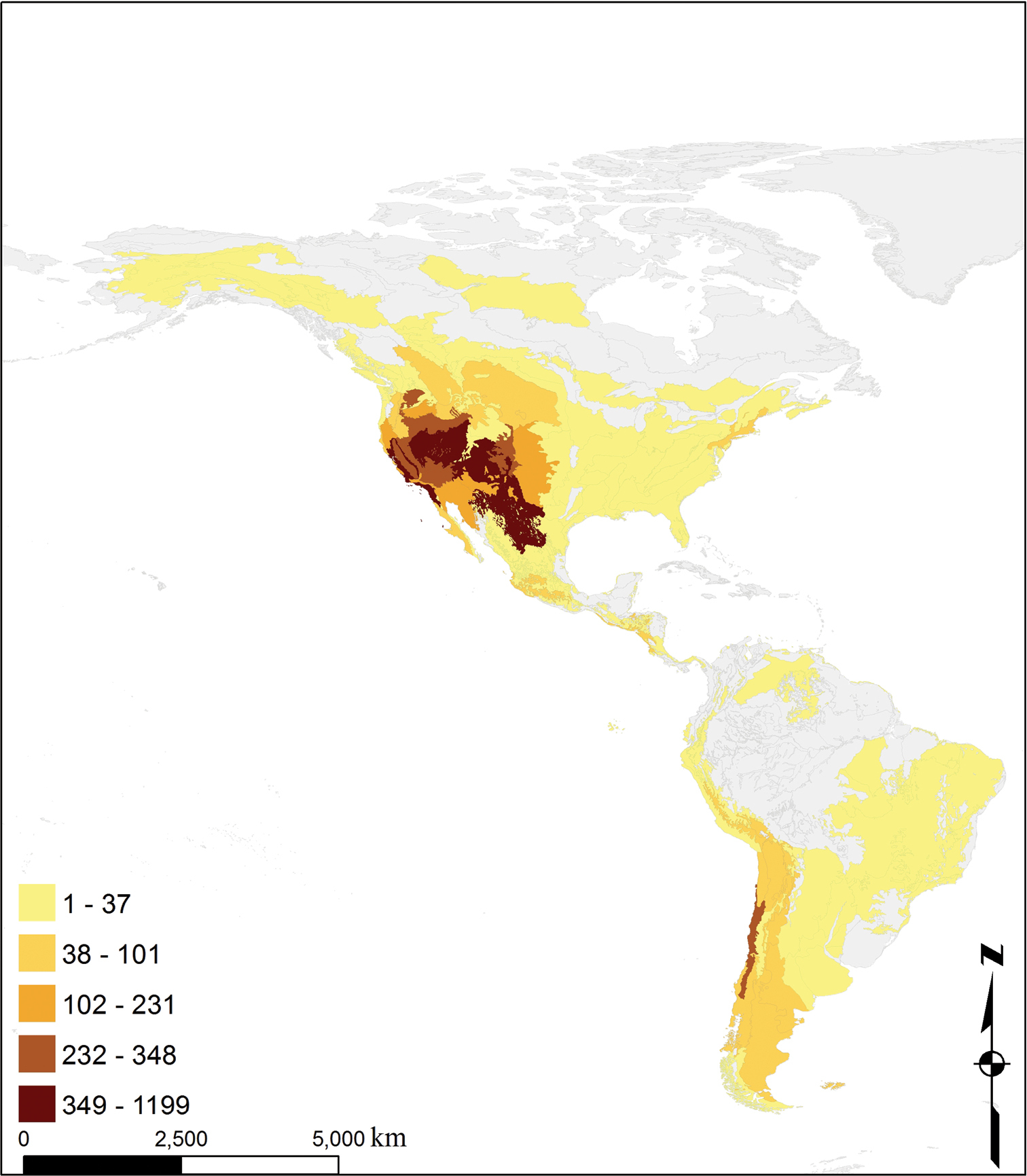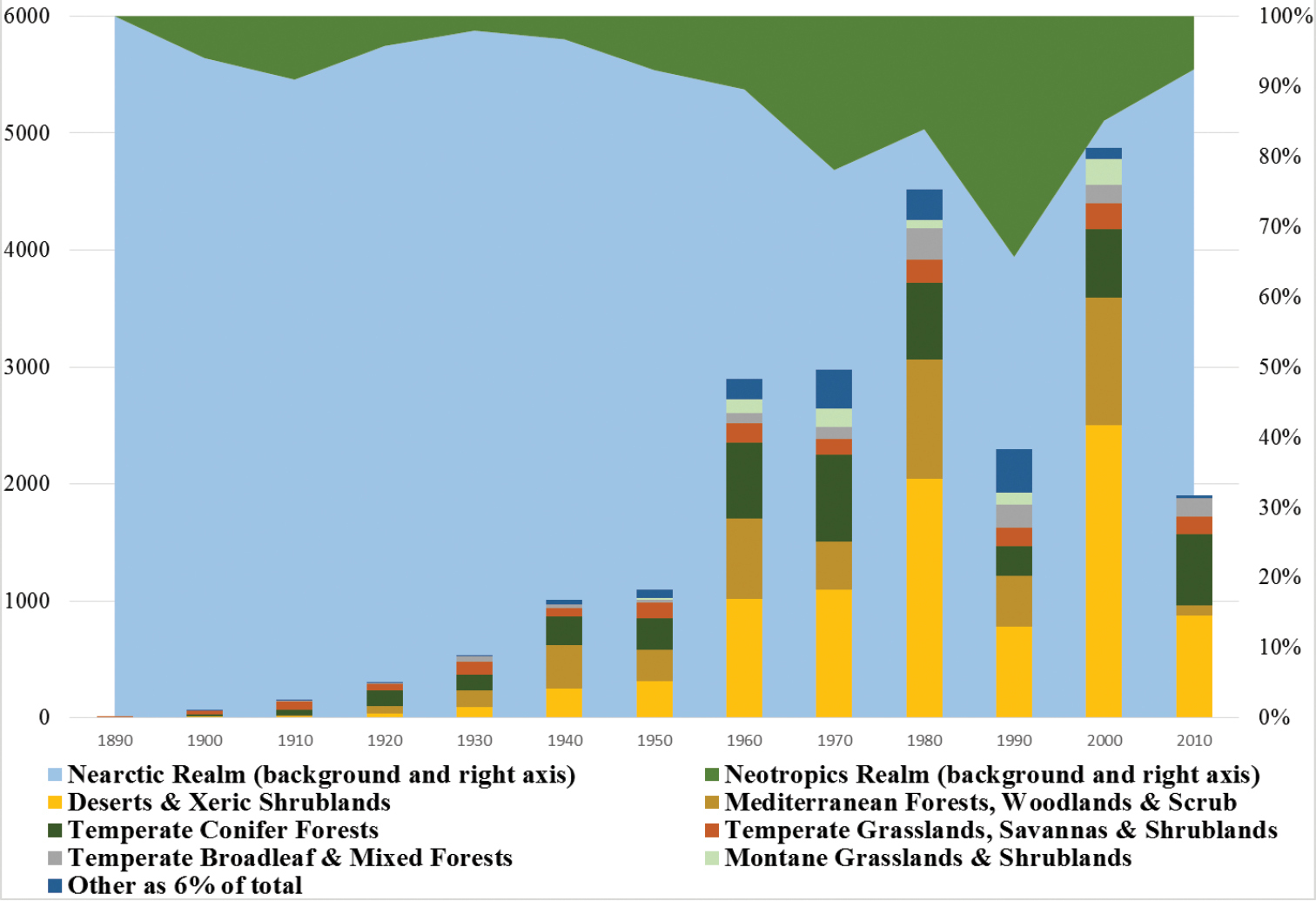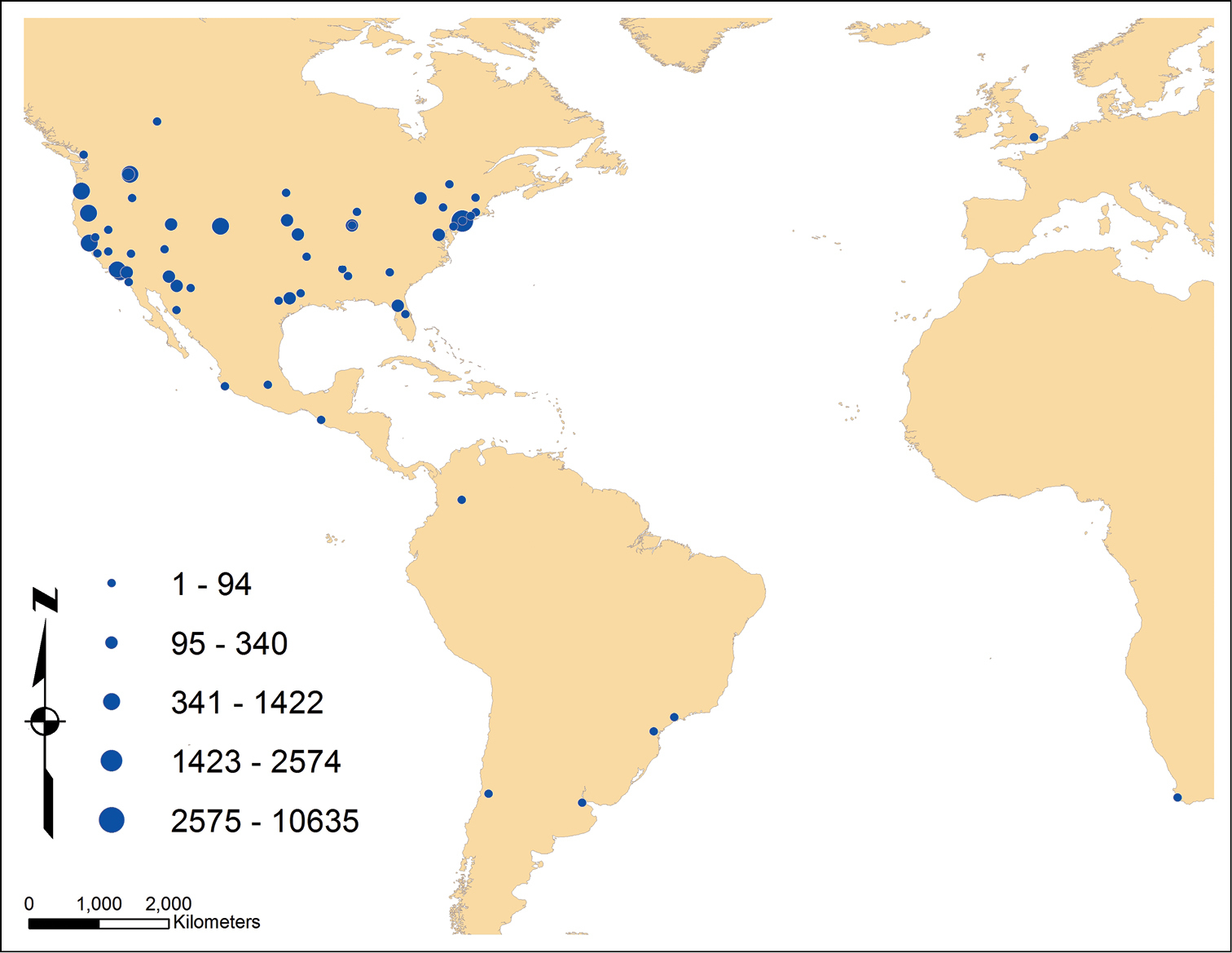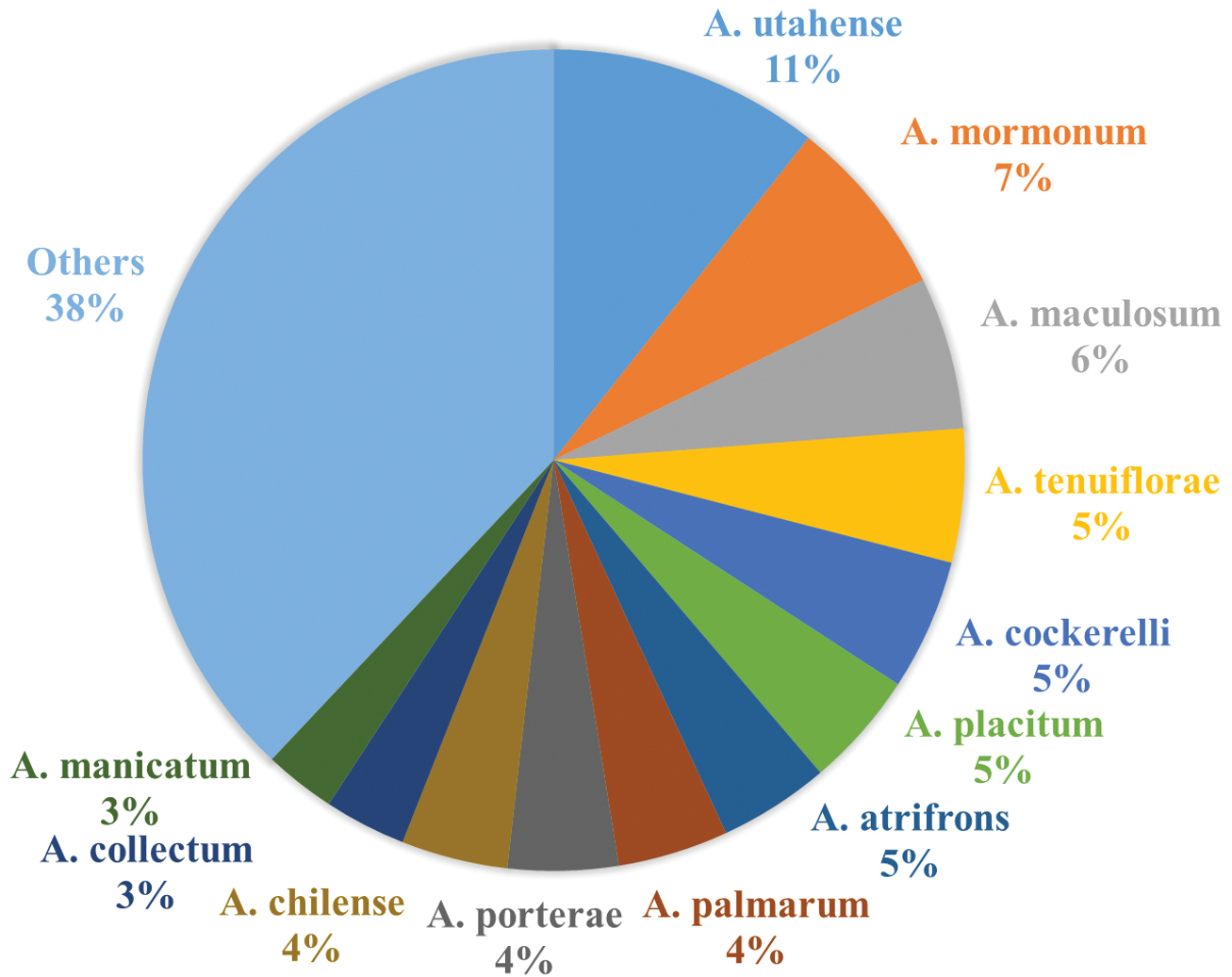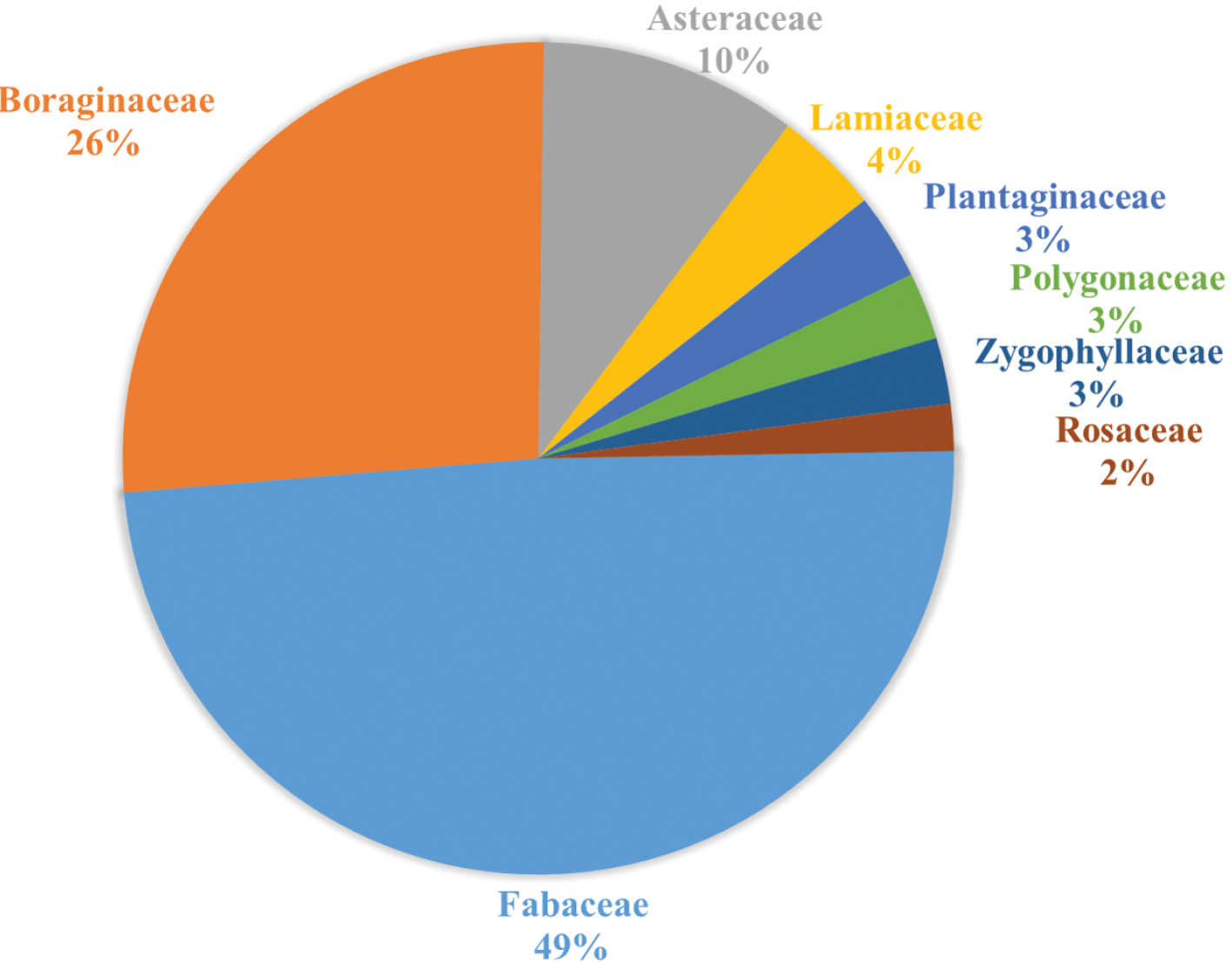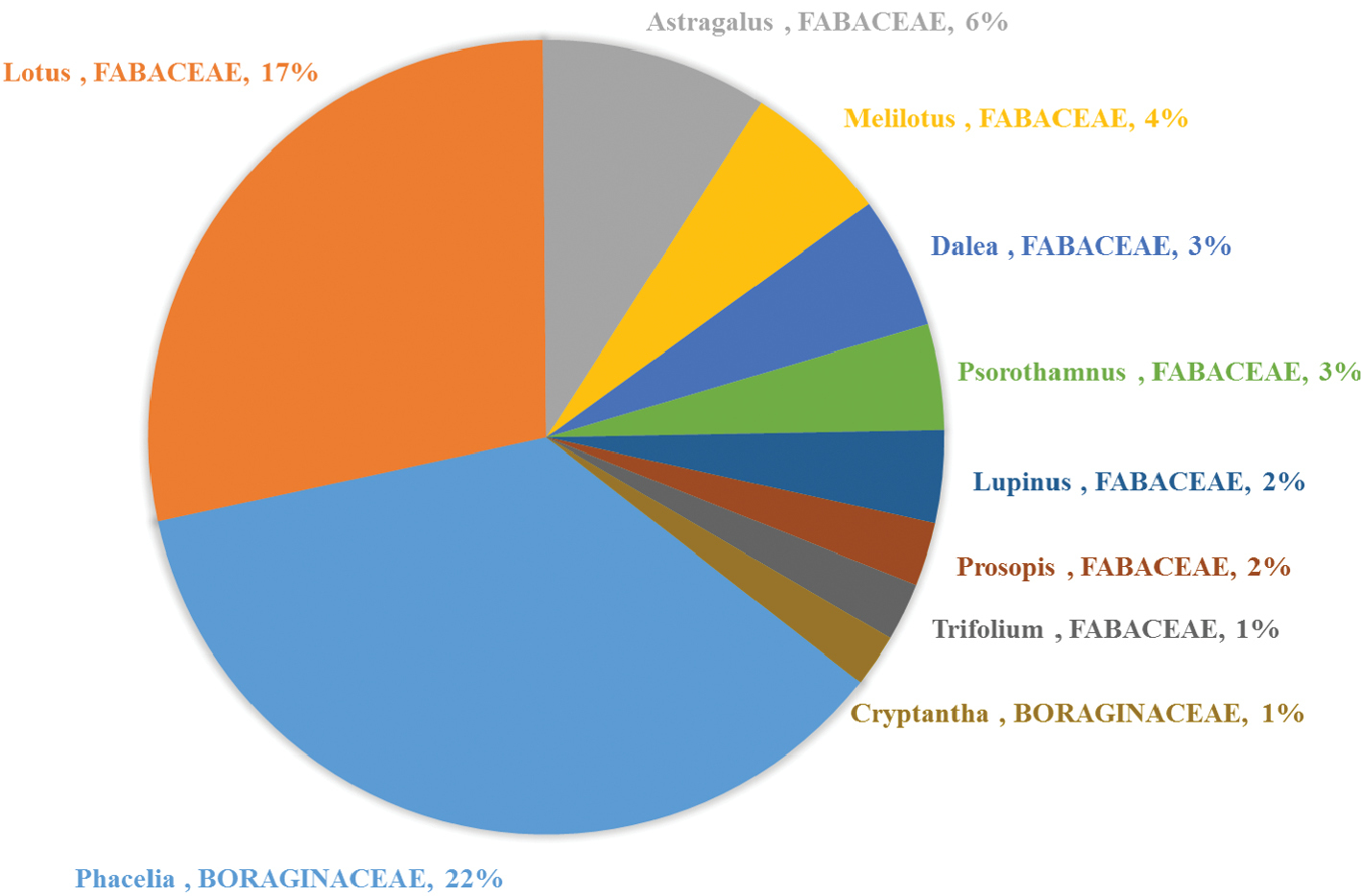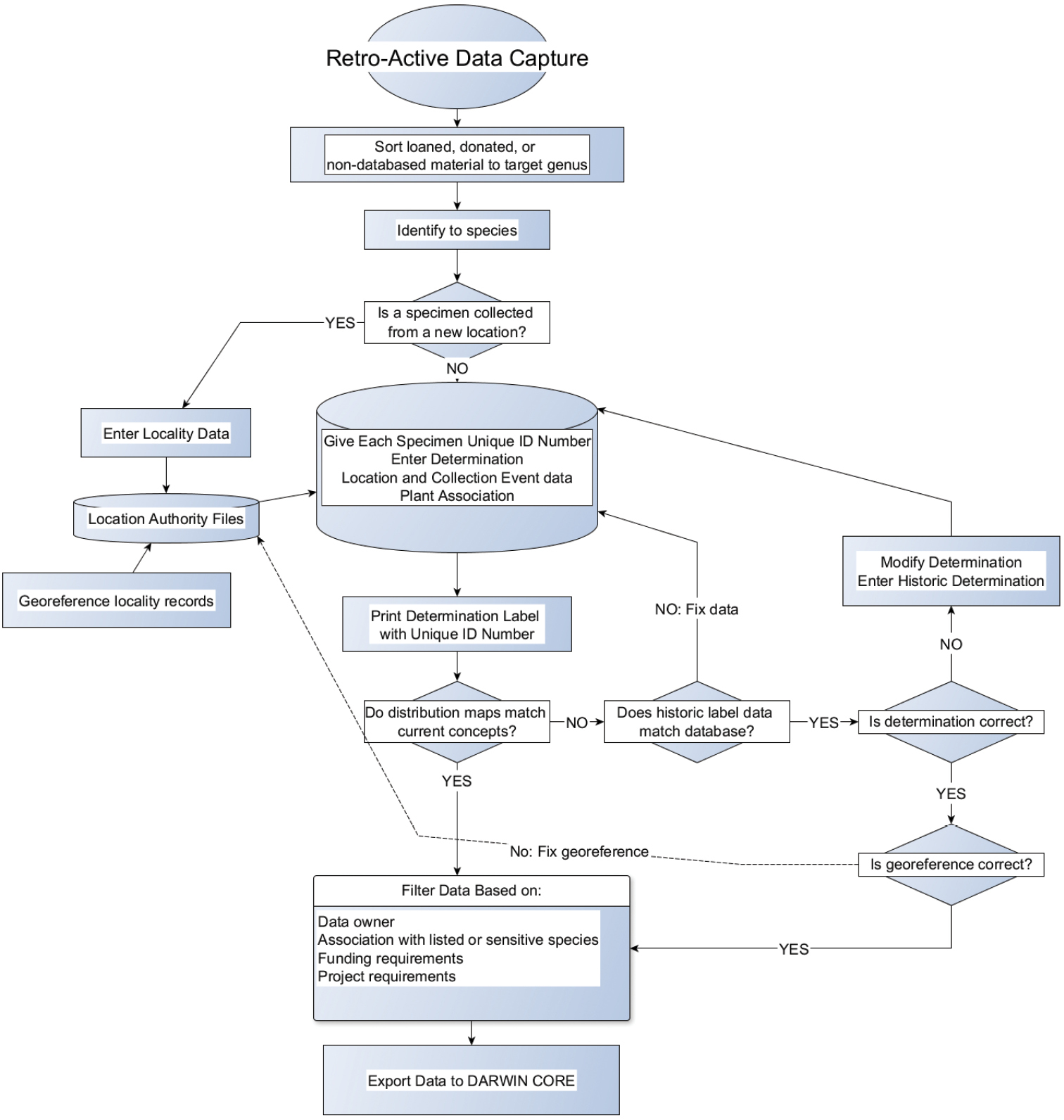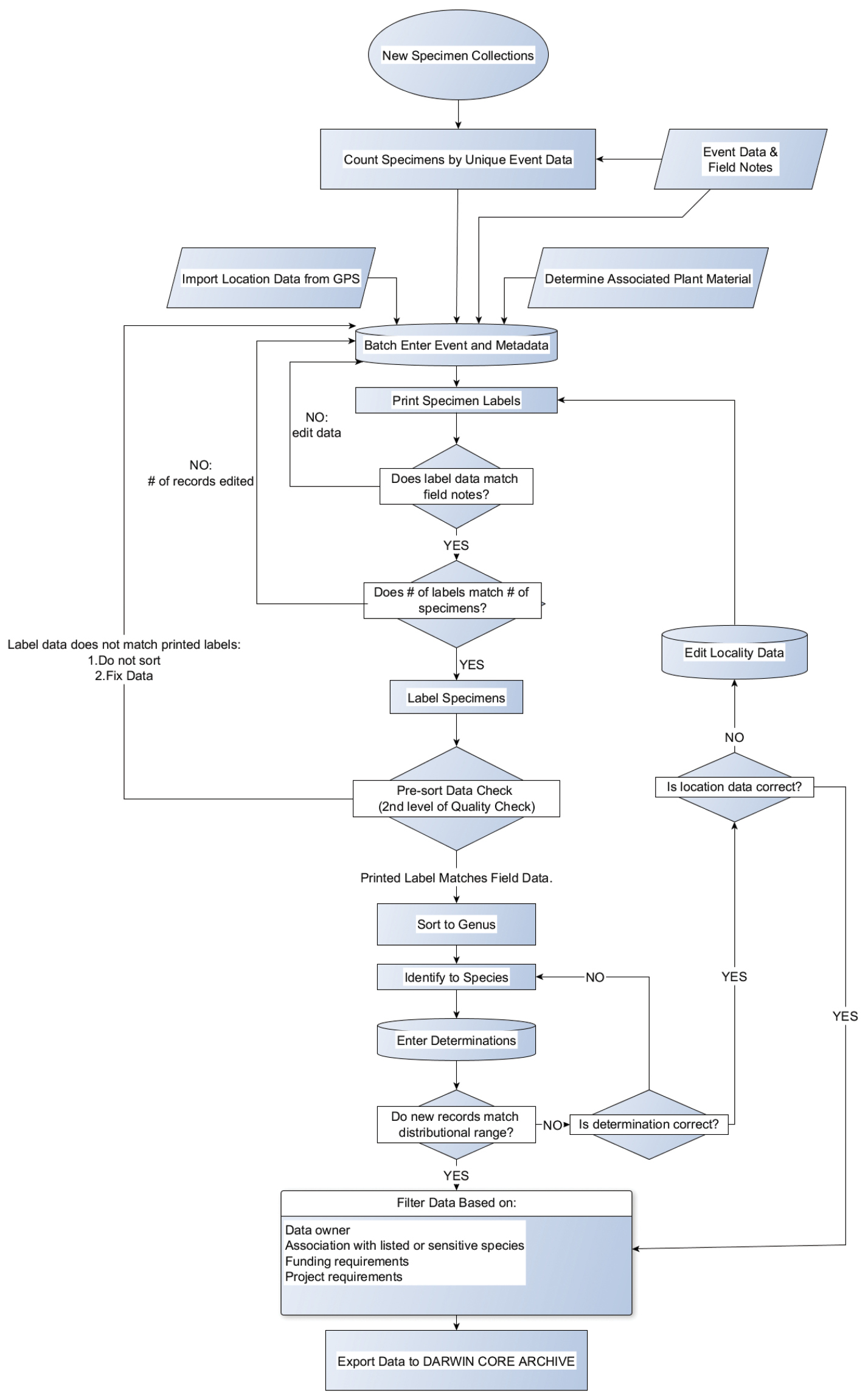






Citation: Griswold T, Gonzalez VH, Ikerd H (2014) AnthWest, occurrence records for wool carder bees of the genus Anthidium (Hymenoptera, Megachilidae, Anthidiini) in the Western Hemisphere. ZooKeys 408: 31–49. doi: 10.3897/zookeys.408.5633 GBIF Key: http://gbrds.gbif.org/browse/agent?uuid=863eed07-c5d8-40ae-baee-23f8d3fa475a
Resource Citation: Griswold T, Gonzalez VH and Ikerd H (2014). AnthWest, occurrence records for wool carder bees of the genus Anthidium (Hymenoptera: Megachilidae, Anthidiini), 22,648 data records. Contributed by Griswold T, Gonzalez VH, Ikerd H, Arduser M, Ascher J, Ayala R, Barnes J, Barr C, Bowers D, Brady S, Brown B, Buck M, Clark S, Clark WH, Danforth B, Engel MS, Falin Z, Fullerton S, Harris B, Hoebeke R, Horsley P, Huntzinger K, Kimsey L, Koch F, Lee V, Luís-Martínez MA, Marshall C, Melo G, Michener CD, Neff J, Notton D, Olson C, Otte D, Packer L, Pagliano G, Paulsen MJ, Pulawski W, Ratcliffe B, Riley E, Ritcher V, Roig Alsina A, Rozen J, Serna F, Scott V, Smith-Pardo A, Spendlove EJ, Stange L, Thomas J, Thorp R, Tinerella P, Urban D, Vergara E, Wall M, Weintraub J, Wiley J, Yanega D, Yañez O, Zimmermann D, and Zuparko RL. Online at http://ipt.pensoft.net/ipt/resource.do?r=anthidium, version 1.0 (last updated on YYYY-MM-DD), Resource ID: GBIF Key: http://gbrds.gbif.org/browse/agent?uuid=863eed07-c5d8-40ae-baee-23f8d3fa475a, Data Paper ID: doi: 10.3897/zookeys.408.5633
This paper describes AnthWest, a large dataset that represents one of the outcomes of a comprehensive, broadly comparative study on the diversity, biology, biogeography, and evolution of Anthidium Fabricius in the Western Hemisphere. In this dataset a total of 22, 648 adult occurrence records comprising 9657 unique events are documented for 92 species of Anthidium, including the invasive range of two introduced species from Eurasia, A. oblongatum (Illiger) and A. manicatum (Linnaeus). The geospatial coverage of the dataset extends from northern Canada and Alaska to southern Argentina, and from below sea level in Death Valley, California, USA, to 4700 m a.s.l. in Tucumán, Argentina. The majority of records in the dataset correspond to information recorded from individual specimens examined by the authors during this project and deposited in 60 biodiversity collections located in Africa, Europe, North and South America. A fraction (4.8%) of the occurrence records were taken from the literature, largely California records from a taxonomic treatment with some additional records for the two introduced species. The temporal scale of the dataset represents collection events recorded between 1886 and 2012. The dataset was developed employing SQL server 2008 r2. For each specimen, the following information is generally provided: scientific name including identification qualifier when species status is uncertain (e.g. “Questionable Determination” for 0.4% of the specimens), sex, temporal and geospatial details, coordinates, data collector, host plants, associated organisms, name of identifier, historic identification, historic identifier, taxonomic value (i.e., type specimen, voucher, etc.), and repository. For a small portion of the database records, bees associated with threatened or endangered plants (~ 0.08% of total records) as well as specimens collected as part of unpublished biological inventories (~17%), georeferencing is presented only to nearest degree and the information on floral host, locality, elevation, month, and day has been withheld. This database can potentially be used in species distribution and niche modeling studies, as well as in assessments of pollinator status and pollination services. For native pollinators, this large dataset of occurrence records is the first to be simultaneously developed during a species-level systematic study.
Anthophila, Apoidea, bees, invasive species, North America, South America, pollinators, biodiversity, floral hosts
Project title: Wool carder bees of the genus Anthidium (Hymenoptera: Megachilidae, Anthidiini) in the Western Hemisphere
Personnel: Terry Griswold (author), Victor H. Gonzalez (author), Harold Ikerd (database manager, author).
Funding: National Science Foundation grants DEB-0742998 and DBI-0956388.
Study area description: The database covers a wide range of ecosystems found in both North and South America, from -62° to 79° in latitude and -174° to -22° in longitude. A large portion of the records in North America are from xeric regions (Great Basin, Colorado Plateau, Mojave, Sonoran, and Chihuahuan Deserts) and Mediterranean California, while those from South America are mostly from the xeric regions on the flanks of the Andes (Figs 1, 2). No records for Anthidium are known from the Caribbean islands. Much of the data set comes from general bee collecting. Additional material in western United States comes from multi-year intensive, systematic bee faunal studies in protected landscapes.
Collecting intensity of Anthidium by ecoregion in the Western Hemisphere. Number of collection events defined as unique date and latitude and longitude combinations per each WWF ecoregion (
Collection intensity across decades by WWF Biomes and Realms. The following biomes comprised less than 3% each and were combined: Tropical and Subtropical Coniferous Forests, Tropical and Subtropical Dry Broadleaf Forests, Tropical and Subtropical Moist Broadleaf Forests, Tropical and Subtropical Grasslands, Savannas and Shrublands, Mangroves, Boreal Forests/Taiga, Rock and Ice, Tundra, and Flooded Grasslands and Savannas.
While the majority of species of Anthidium occupy a small number of ecoregions (< 5), some species such as Anthidium tenuiflorae Cockerell are widespread, occurring in as many as 41 ecoregions. Many Anthidium have distributions that include critical, endangered, or vulnerable, as well as relatively stable or intact, ecoregions (Table 1) based on WWF (World Wild Fund for Nature) designations (
Distribution and relative abundance of species of Anthidium by ecoregions in the Western Hemisphere. For a particular species, abundance on WWF designated ecoregion status was estimated as the percentage of specimen records occurring in those ecoregions over the total number of specimen records of that species.
| Species | # of Ecoregions | # of specimens | Ecoregion Status | ||
|---|---|---|---|---|---|
| Critical or Endangered (%) | Vulnerable (%) | Relatively Stable or Intact (%) | |||
| Anthidium adelphum | 3 | 48 | 2 | 2 | 96 |
| Anthidium adriani | 3 | 19 | 100 | 0 | 0 |
| Anthidium alsinai | 1 | 1 | 0 | 100 | 0 |
| Anthidium andinum | 4 | 10 | 20 | 80 | 0 |
| Anthidium anurospilum | 3 | 22 | 0 | 18 | 82 |
| Anthidium atacamense | 4 | 18 | 6 | 17 | 78 |
| Anthidium atrifrons | 26 | 985 | 42 | 19 | 39 |
| Anthidium atripes | 16 | 471 | 6 | 38 | 56 |
| Anthidium atripoides | 3 | 127 | 0 | 0 | 100 |
| Anthidium aymara | 4 | 13 | 23 | 69 | 8 |
| Anthidium aztecum | 3 | 11 | 100 | 0 | 0 |
| Anthidium banningense | 19 | 370 | 65 | 13 | 22 |
| Anthidium cafayate | 3 | 4 | 0 | 100 | 0 |
| Anthidium calchaqui | 3 | 8 | 0 | 100 | 0 |
| Anthidium chamelense | 4 | 17 | 100 | 0 | 0 |
| Anthidium chilense | 8 | 947 | 96 | 1 | 3 |
| Anthidium chubuti | 6 | 15 | 67 | 0 | 33 |
| Anthidium clypeodentatum | 25 | 177 | 45 | 18 | 37 |
| Anthidium cochimi | 11 | 88 | 7 | 47 | 47 |
| Anthidium cockerelli | 13 | 1169 | 1 | 6 | 93 |
| Anthidium collectum | 16 | 730 | 47 | 50 | 4 |
| Anthidium colliguayanum | 3 | 54 | 96 | 0 | 4 |
| Anthidium cuzcoense | 2 | 8 | 88 | 13 | 0 |
| Anthidium dammersi | 7 | 333 | 0 | 4 | 95 |
| Anthidium danieli | 2 | 8 | 88 | 0 | 13 |
| Anthidium danunciae | 1 | 5 | 0 | 100 | 0 |
| Anthidium decaspilum | 5 | 34 | 24 | 3 | 74 |
| Anthidium deceptum | 5 | 112 | 0 | 86 | 14 |
| Anthidium duomarginatum | 6 | 210 | 8 | 0 | 92 |
| Anthidium edwardsii | 15 | 369 | 63 | 31 | 6 |
| Anthidium edwini | 3 | 13 | 92 | 0 | 8 |
| Anthidium emarginatum | 14 | 505 | 40 | 7 | 53 |
| Anthidium espinosai | 5 | 47 | 15 | 2 | 83 |
| Anthidium formosum | 19 | 167 | 51 | 15 | 34 |
| Anthidium friesei | 8 | 183 | 4 | 91 | 4 |
| Anthidium funereum | 12 | 174 | 15 | 39 | 46 |
| Anthidium gayi | 7 | 502 | 93 | 2 | 5 |
| Anthidium hallinani | 9 | 137 | 93 | 7 | 0 |
| Anthidium igori | 1 | 5 | 0 | 100 | 0 |
| Anthidium illustre | 16 | 539 | 42 | 42 | 16 |
| Anthidium insignissimum | 2 | 13 | 31 | 69 | 0 |
| Anthidium jocosum | 14 | 422 | 15 | 15 | 69 |
| Anthidium kolla | 2 | 9 | 0 | 100 | 0 |
| Anthidium labergei | 2 | 38 | 0 | 95 | 5 |
| Anthidium larocai | 1 | 1 | 0 | 100 | 0 |
| Anthidium latum | 5 | 11 | 27 | 73 | 0 |
| Anthidium luizae | 1 | 1 | 0 | 100 | 0 |
| Anthidium maculifrons | 39 | 522 | 80 | 19 | 1 |
| Anthidium maculosum | 35 | 1356 | 55 | 24 | 22 |
| Anthidium macushi | 4 | 32 | 0 | 94 | 6 |
| Anthidium manicatum | 23 | 635 | 53 | 3 | 44 |
| Anthidium mapuche | 4 | 44 | 89 | 0 | 11 |
| Anthidium masunariae | 1 | 2 | 100 | 0 | 0 |
| Anthidium meloi | 1 | 5 | 0 | 100 | 0 |
| Anthidium michenerorum | 4 | 16 | 94 | 0 | 6 |
| Anthidium mormonum | 32 | 1612 | 51 | 15 | 35 |
| Anthidium multispinosum | 1 | 1 | 0 | 100 | 0 |
| Anthidium neffi | 1 | 1 | 100 | 0 | 0 |
| Anthidium nigerrimum | 4 | 6 | 17 | 50 | 33 |
| Anthidium oblongatum | 7 | 163 | 96 | 4 | 0 |
| Anthidium paitense | 1 | 7 | 0 | 100 | 0 |
| Anthidium pallidiclypeum | 8 | 181 | 14 | 34 | 52 |
| Anthidium palliventre | 9 | 396 | 66 | 32 | 2 |
| Anthidium palmarum | 17 | 984 | 7 | 12 | 81 |
| Anthidium parkeri | 11 | 187 | 93 | 7 | 0 |
| Anthidium paroselae | 9 | 563 | 0 | 3 | 97 |
| Anthidium penai | 2 | 26 | 100 | 0 | 0 |
| Anthidium peruvianum | 3 | 23 | 0 | 91 | 9 |
| Anthidium placitum | 22 | 1034 | 30 | 19 | 51 |
| Anthidium platyfrons | 1 | 3 | 0 | 0 | 100 |
| Anthidium porterae | 18 | 982 | 41 | 31 | 27 |
| Anthidium psoraleae | 7 | 17 | 88 | 0 | 12 |
| Anthidium quetzalcoatli | 7 | 38 | 95 | 0 | 5 |
| Anthidium rafaeli | 2 | 9 | 0 | 100 | 0 |
| Anthidium rodecki | 6 | 411 | 21 | 1 | 79 |
| Anthidium rodriguezi | 14 | 74 | 96 | 4 | 0 |
| Anthidium rozeni | 1 | 1 | 0 | 100 | 0 |
| Anthidium rubripes | 11 | 76 | 9 | 70 | 21 |
| Anthidium sanguinicaudum | 4 | 8 | 13 | 88 | 0 |
| Anthidium schwarzi | 9 | 104 | 12 | 61 | 28 |
| Anthidium sertanicola | 1 | 1 | 0 | 100 | 0 |
| Anthidium sonorense | 10 | 77 | 3 | 12 | 86 |
| Anthidium sparsipunctatum | 4 | 90 | 3 | 97 | 0 |
| Anthidium spatulatum | 2 | 41 | 2 | 0 | 98 |
| Anthidium tarsoi | 1 | 2 | 0 | 100 | 0 |
| Anthidium tenuiflorae | 41 | 1189 | 37 | 22 | 42 |
| Anthidium toro | 2 | 65 | 0 | 22 | 78 |
| Anthidium utahense | 29 | 2409 | 39 | 49 | 12 |
| Anthidium vigintiduopunctatum | 9 | 41 | 24 | 76 | 0 |
| Anthidium vigintipunctatum | 4 | 30 | 3 | 97 | 0 |
| Anthidium weyrauchi | 1 | 11 | 0 | 100 | 0 |
Design description: The purpose of this dataset is to make available data associated with bees of the genus Anthidium in the Western Hemisphere. The dataset was developed during the course of a species-level revision of the genus (
Location of 60 insect collections with number of specimens of Anthidium examined.
Databasing processes for the USNPID have evolved over the 25 years since initiation. Processing, originally considered as too costly, has since been incorporated into the databasing process. Verbatim label data capture originally only for holotypes, was expanded first to loaned specimens and now to all retro-active data capture. When validity of entry fields is questioned, verbatim information is queried before pulling the specimen from the collection, saving both time and potential handling hazards. Addition of that tracking data (e.g. date of record entry, date of record modification, logging of entry person) and use of authority tables were essential to data quality, yet amounted to negligible additional data capture costs.
The data underpinning the analysis reported in this paper are deposited at GBIF, the Global Biodiversity Information Facility, http://ipt.pensoft.net/ipt/resource.do?r=anthidium.
General taxonomic coverage description: The coverage of this dataset includes all 92 species of the bee genus Anthidium known to occur in the Western Hemisphere, including two that are introduced. Anthidium belongs to the tribe Anthidiini and is among the most diverse genera of the family Megachilidae. Based on the materials used in nest construction, anthidiines are broadly classed into two groups, carder bees and resin bees. While resin bees are generically diverse in the Western Hemisphere, Anthidium is the sole representative of carder bees in the Americas. As such this dataset documents all of a functional bee group for the Americas. The greatest number of data records are for two widespread western North American species, Anthidium utahense Swenk (2409 records) and Anthidium mormonum Cresson (1615 records) (Fig. 4). The species with the least number of records are Anthidium alsinai Urban, Anthidium isabelae Urban, Anthidium larocai Urban, Anthidium luizae Urban, Anthidium multispinosum Gonzalez & Griswold, Anthidium neffi Gonzalez & Griswold, and Anthidium rozeni Urban, each represented by a single data record. Though these species are rare in collections, there is no knowledge whether they are rare in nature, though at least for Anthidium multispinosum, it is likely that it has a restricted distribution. No Anthidium in the Western Hemisphere have formally been listed as threatened or endangered.
Percentage of specimen records per species of Anthidium in the AnthWest database. The category “Others” correspond to remaining species with specimen records accounting for less than 2%. All individual species shown except Anthidium chilense are Nearctic.
Anthidium are occasionally associated with rare, threaten or endangered plants. Only a handful of such associations with state and/or federally listed plant bee records are included in the dataset (Table 2). Published records provide georeference only to the nearest degree, and floral host, month and day fields will have information hidden.
Species of Anthidium of the Western Hemisphere recorded from rare, threaten or endangered plants.
| Plant species | Bee species | # of records |
|---|---|---|
| Asteraceae | ||
| Erigeron rhizomatus Cronquist | Anthidium mormonum | 3 |
| Anthidium duomarginatum | 3 | |
| Anthidium maculosum | 1 | |
| Cactaceae | ||
| Sclerocactus mesae-verdae (Boissev. ex Hill & Salisb.) L.D. Benson | Anthidium emarginatum | 1 |
| Pediocactus sileri (Boissev. ex Hill & Salisb.) L.D. Benson | Anthidium emarginatum | 1 |
| Fabaceae | ||
| Astragalus humillimus A. Gray | Anthidium dammersi | 2 |
| Dalea formosa Torr. | Anthidium palmarum | 7 |
All specimens in this dataset have been reviewed by the authors or are easily determined taxa that have been reviewed by experts in bee taxonomy (e.g., John Ascher, for some AMNH material; A. A. Grigarick and L. A. Stange for California records in
General spatial coverage: This dataset includes species occurrences of bees in the genus Anthidium across the entire Western Hemisphere, from Alaska to southern Chile and southern Argentina, and from below sea level in Death Valley, California, USA, to 4700 m a.s.l. in Tucumán, Argentina. Within North America coverage is most complete for temperate regions, though diminishing diversity correlated with declining latitude cannot be ignored.
Records in AnthWest span more than a century, from May 1886 to February 2012. The majority of the records are from the past four decades (Fig. 2). In temperate North America, here restricted to Canada and the United States, Anthidium is most active during the late spring and summer months; the majority of the records are for May through August. In alpine regions (> 3000m) the season is narrowed to May through September, but largely June through August, peaking in July.
Dataset description: AnthWest is a result of a broadly comparative study on the diversity, biology, biogeography, and evolution of bees in the genus Anthidium in the Western Hemisphere. The dataset includes 22, 648 occurrence records for 92 species of Anthidium, including two introduced species from Eurasia. Each record consists of the species name, locality, collector’s name, collection date, latitude, longitude, host plants, associated organisms, name of identifier, taxonomic value (i.e., type specimen, voucher, etc.), and repository. When coordinates for collection sites were not provided on the label, they were extracted using Google Earthtm (http://earth.google.com/) or GEOlocate (http://www.museum.tulane.edu/geolocate/). To guarantee the high quality of the data, most records in the dataset correspond to individual specimens examined by the authors during this project, representing 60 biodiversity collections in Europe, Africa, North and South America (Fig. 3). A small fraction (4.8%) of the occurrence records were extracted from the literature. Only literature records for which there was a high degree of certainty in the identification were included. The vast majority of these published records were taken from the rigorous study of California Anthidiini by
As with most other bees, floral resources are essential for reproductive success of Anthidium. Floral records indicate a broad array of floral visitation based on the quarter (24%) of AnthWest records that include floral visits. While visitation includes 56 plant families and over 100 species, Fabaceae and Boraginaceae dominated the dataset, together accounting for 75% of the records (Fig. 5).
Plant families visited by Anthidium in the Western Hemisphere. Only families represented by at least 2% of the total 5358 floral visitation records in the database are shown.
Analysis of plant records at the generic level similarly shows the dominance of Fabaceae and Boraginaceae; all top ten floral associations belong to these two families, but Phacelia, the most visited genus belongs not to Fabaceae but to Boraginaceae (Fig. 6).
Records for 34 name-bearing types of Anthidium are also included in the database.
Percentage of plant records for the ten most visited plant genera (n = 5358 floral visitation records).
Study extent: Because this dataset was developed as part of research that was focused on taxonomic revisionary work, sampling was not the focus of efforts; rather the data represents the aggregate of what we know about the distribution and behavior of Anthidium from existing material. Carder bees are diurnal, and are only active when temperatures are well above freezing and only during the growing season when floral resources are potentially available.
Sampling description: Specimen records captured in AnthWest are the result of: 1) non-systematic collections usually as part of general entomological collecting events or ones focused on bees in general; 2) standardized biodiversity surveys conducted by the USDA Pollinating Insects Research Unit using a combination of net and pan traps; 3) trap nest studies; and 4) specimens resulting from studies on pollination and reproductive biology of threatened or endangered plants.
Quality control: All individual specimens included in this dataset were examined during the course of the taxonomic revision using distribution maps and raw data following standardized protocols (Figs 7, 8). Records with questionable data on original insect labels were included in the dataset but distinguishable by notes in the DWC field “Identification Qualifier”. These records were excluded from published distribution maps in the species-level revision of the genus (
Flow chart for retroactive data capture of museum specimens.
Step description: Two separate work flows were employed for data capture, which differed fundamentally on where in the process material was determined by the revisionary authors. Retroactive data capture (Fig. 7) incorporated loaned specimens, publication records, and previously non-databased specimens in the U.S. National Pollinating Insects Collection, all of which follows after the identification process. Publication records were treated similarly to retroactive data capture except each record represents a summation of males and females with identical collecting event data. Beginning in 2005, new specimen records (Fig. 8) were batch entered into the database for projects and opportunistic collection events alike. Specimen identification and subsequent update to the database occurred after record and event metadata had been entered. New specimen collections also had a work flow that resulted in a greater number of data quality checks by technicians and primary researchers.
Flow chart for processing of new specimen samples.
Purpose: The purpose of this dataset is to make available data associated with bees of the genus Anthidium in the Western Hemisphere. The dataset was developed during the course of a species-level revision of the genus (
IP Rights: Licenses of use: This work is licensed under a Creative Commons Attribution-NonCommercial-ShareAlike 3.0 Unported License. http://creativecommons.org/licenses/by-nc-sa/3.0/ Records highlighted in the Darwin Core [DWC] fields “rights” and “rightsholder” indicate specimens that have addition usage rights.
Collection Data: For all collections, including those not listed in the Global Registry of Biodiversity Repositories (www.grbio.org) the Institution code listed below is included in the DWC field “owner Institution Code”.
AMNH American Museum of Natural History, New York, New York, USA [2574 records]
ARDU M. Arduser, Missouri Department of Conservation, St. Charles, Missouri [32 records]
ASUT Arizona State University, Frank M.H. Natural History Museum, Tempe, Arizona, USA [145 records]
BBNP Big Bend National Park, Big Bend, Texas, USA [7 records]
BBSL USDA-ARS Bee Biology and Systematic Laboratory, Logan, Utah, USA [11123 records]
BNHM British Natural History Museum, London, UK [19 records]
BYUC Monte L. Bean Life Science Museum, Arthropod Collection, Provo, Utah, USA [105 records]
CAES Connecticut Agriculture Experiment Station, New Haven, Connecticut, USA [30 records]
CAS California Academy of Sciences, San Francisco, California, USA [637 records]
CEET Colección de Insectos Asociados a Plantas Cultivadas en la Frontera Sur, El Colegio de la Frontera Sur, Tapachula, Chiapas, Mexico [1 record]
CIDA College of Idaho, Museum of Natural History, Caldwell, Idaho, USA [25 records]
CNC Canadian National Collection of Insects, Arachnids & Nematodes, Ottawa, Ontario, Canada [5 records]
CTMI Central Texas Melittological Institute, Austin, Texas, USA [34 records]
CUIC Cornell University Insect Collection, Ithaca, New York, USA [33 records]
DEVA Death Valley National Park, Furnace Creek, California, USA [11 records]
DZUP Departamento de Zoologia, Universidade Federal do Paraná, Curitiba, Brazil [16 records]
EBCC Estación de Biología Chamela, Universidad Nacional Autónoma de Mexico, San Patricio, Jalisco, Mexico [24 records]
EMEC Essig Museum of Entomology, University of California, Berkeley, California, USA [1173 records]
FCDA Fresno County Department of Agriculture, Fresno, California, USA [3 records]
FMNH Field Museum of Natural History, Chicago, Illinois, USA [7 records]
FSCA Florida State Collection of Arthropods, Florida State University, Gainesville, Florida, USA [122 records]
GSENM Grand Staircase-Escalante National Monument, Kanab, Utah, USA [12 records]
HNH_ent Dartmouth College, Hanover, New Hampshire, USA [1 record]
INHS Illinois Natural History Survey, Urbana, Illinois, USA [161 records]
LACM Natural History Museum of Los Angeles County, Los Angeles, California, USA [1422 records]
MACN Museo Argentino de Ciencias Naturales ‘Bernardino Rivadavia’, Buenos Aires, Argentina [36 records]
MEM Mississippi Entomological Museum, Mississippi State University, Starkville, Mississippi, USA [6 records]
MEUC Colección del Museo Entomológico Luis Peña, Departamento de Sanidad Vegetal, Universidad de Chile, Santiago, Chile [1 record]
SS; RR Snelling and G.I. Stage personal collections; USA [9 records]
MZUSP Museu de Zoologia, Universidade de São Paulo, São Paulo, Brazil [4 records]
NMNH Smithsonian National Museum of Natural History, Washington, D.C., USA [340 records]
NVDA Nevada State Department of Agriculture, Reno, Nevada, USA [17 records]
NYBG New York Botanical Garden, New York, New York, USA [1 record]
OSAC Oregon State Arthropod Collection, Corvallis, Oregon, USA [580 records]
PCYU Packer’s Apoidea Collection at York University, Toronto, Ontario, Canada [239 records]
PHIL University of the Sciences in Philadelphia, Philadelphia, Pennsylvania, USA [32 records]
PINN Pinnacles National Monument, Paicines, California, USA [6 records]
PMAE Royal Alberta Museum, Edmonton, Alberta, Canada [12 records]
RUDZ Rhodes University, Grahamstown, South Africa, [44 records]
SDNHM San Diego Natural History Museum, San Diego, California, USA [94 records]
SDSU Severin-McDaniel Insect Collection, South Dakota State University, Brookings, South Dakota, USA [48 records]
SEMC Snow Entomological Museum, University of Kansas, Lawrence, Kansas, USA [246 records]
SFUC Simon Fraser University, Burnaby, British Columbia, Canada [1 record]
SWRS Southwestern Research Station, Portal, Arizona, USA [7 records]
TAMU Texas A&M University Insect Collection, College Station, Texas, USA [101 records]
UAAM University of Arkansas Arthropod Museum, Fayetteville, Arkansas, USA [4 records]
UAIC University of Arizona Insect Collection, Tucson, Arizona, USA [150 records]
UCDC R.M. Bohart Museum of Entomology, University of California, Davis, California, USA [658 records]
UCF University of Central Florida Collection of Arthropods, Department of Biology, Orlando, Florida, USA [61 Records]
UCMC University of Colorado Museum of Natural History, Boulder, Colorado, USA [762 records]
UCMS University of Connecticut, Storrs, Connecticut, USA [38 records]
UCR University of California, Riverside, California, USA [298 records]
UGCA University of Georgia, Athens, Georgia, USA [68 records]
UNAB Museo Entomológico, Departamento de Agronomía, Universidad Nacional de Colombia, Bogotá, Colombia [1 record]
UNAM Museo de Zoología Alfonso L. Herrera, Facultad de Ciencias, Universidad Nacional Autónoma de México, Mexico [33 records]
UNSM University of Nebraska State Museum, Lincoln, Nebraska, USA [111 records]
USON Universidad de Sonora, Hermosillo, Sonora, Mexico [1 record]
WFBM W.F. Barr Entomological Collection, University of Idaho, Moscow, Idaho, USA [639 records]
WSU Maurice T. James Entomological Collection, Washington State University, Pullman, Washington, USA [110 records]
ZAVOR Zavortink Private Collection, Davis, California, USA [14 records]
Specimen preservation method and curatorial units: Records represent pinned, dried adult individuals with attached label data stored in most cases in standard insect museum drawers preserved from dermestid damage by routine freezing of drawers at -20 C. Reviewed Anthidium specimens followed the basic process for Hymenoptera preservation and labeling outlined in
Object name: Darwin Core Archive Wool carder bees of the genus Anthidium in the Western Hemisphere
Character encoding: UTF-8
Format name: Darwin Core Archive format
Format version: 1.0
Distribution: http://ipt.pensoft.net/ipt/archive.do?r=anthidium
Publication date of data: 2013-03-25
Language: English
Licenses of use: The U.S. National Pollinating Insects Database [United States Department of Agriculture, Agriculture Research Service, Bee Biology and Systematics Laboratory, Logan, Utah] is made available under the Open Database License: http://opendatacommons.org/licenses/odbl/1.0/. Any rights in individual contents of the database are licensed under the Database Contents License: http://opendatacommons.org/licenses/dbcl/1.0/.
Metadata language: English
Date of metadata creation: 2012-06-27
Hierarchy level: Dataset
We are greatly indebted to each of the curators, collection managers, and staff from the collections that we visited, or from which we borrowed specimens for this study. This work would not have been possible without their constant and valuable support. The names of the institutions and their personnel are indicated in the section of Material and Methods of
